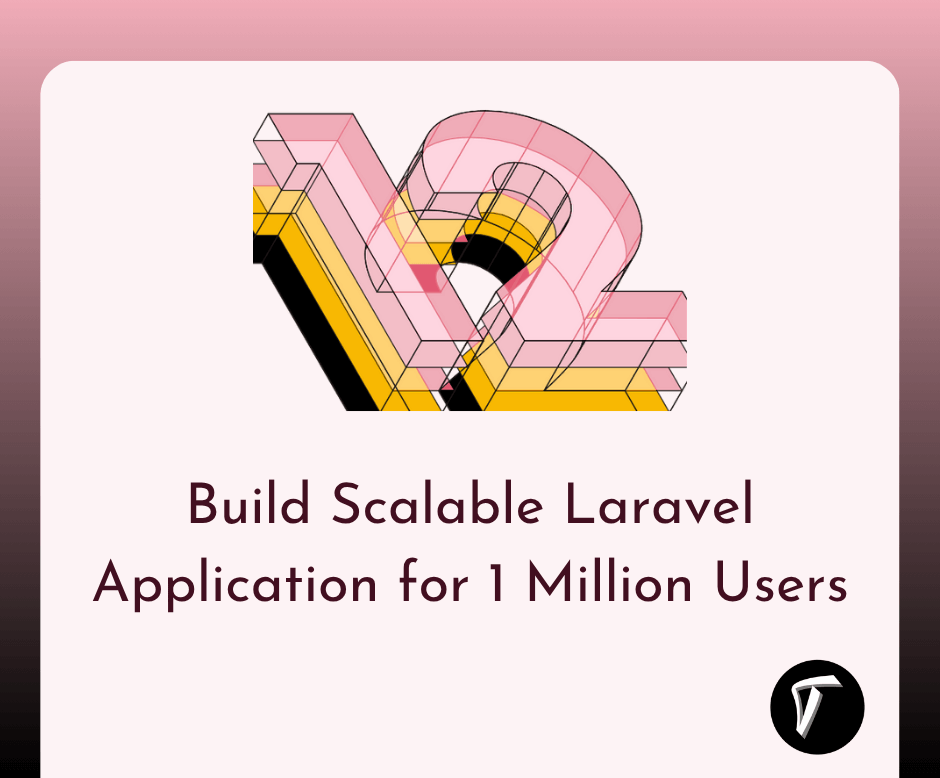How to Build Scalable Laravel Application for 1 Million Users
Hi, I’m a web developer who’s worked with Laravel for years, and I’ve learned what it takes to build an app that can handle massive traffic—like 1 million users! Laravel is a powerful PHP framework, but scaling it for such a large audience requires careful planning and optimization.
In this article, I’ll walk you through the process in simple, easy-to-understand steps. Whether you’re a beginner or an experienced developer, my goal is to help you create a Laravel app that’s fast, reliable, and ready for growth.
Let’s dive into how to build a scalable Laravel application that can handle 1 million users without breaking a sweat!
Step-by-Step Guide to Building a Scalable Laravel Application

Step 1: Plan Your Application Architecture
Before writing any code, I always start by planning the architecture. A solid structure ensures your app can handle growth. For 1 million users, I recommend a microservices or modular monolith approach with Laravel. This means breaking your app into smaller, independent components (like user management, payments, or notifications) that can scale separately.
- Choose a modular structure: Use Laravel’s package system or separate modules for features to keep your codebase organized.
- Database design: Plan your database schema with normalized tables to avoid redundancy and ensure fast queries.
- API-first mindset: Build your app with APIs (using Laravel’s API resources) to make it easier to scale and integrate with other services.
Step 2: Optimize Your Database
The database is the heart of your app, and for 1 million users, it needs to be fast and efficient. I’ve found that optimizing your database early saves headaches later.
- Use MySQL or PostgreSQL: Both are great for Laravel and handle large datasets well. I prefer PostgreSQL for its advanced features like JSON support.
- Indexing: Add indexes to frequently queried columns (e.g., user IDs, emails) to speed up searches.
- Database sharding: If your data grows massive, split it across multiple databases (sharding) to distribute the load.
- Caching: Use Laravel’s query caching with Redis or Memcached to reduce database hits. For example, cache user profiles or frequently accessed data.
Step 3: Implement Caching Strategies
Caching is my go-to for boosting performance. For a high-traffic Laravel app, caching reduces server load and speeds up response times.
- Use Laravel’s Cache System: Store frequently accessed data (like homepage content or user sessions) in Redis or Memcached.
- Cache database queries: Use the
remembermethod in Laravel to cache query results. For example:$users = Cache::remember('users', 60, function () { return DB::table('users')->get(); }); - Full-page caching: For static pages, use Laravel’s view caching or a reverse proxy like Varnish.
- CDN for assets: Serve images, CSS, and JavaScript through a Content Delivery Network (CDN) like Cloudflare to reduce server load.
Step 4: Leverage Queues for Background Tasks
Handling 1 million users means dealing with tasks like sending emails, processing payments, or generating reports. I always use Laravel’s queue system to handle these tasks in the background.
- Set up queues: Use Laravel’s built-in queue system with a driver like Redis or AWS SQS.
- Offload heavy tasks: For example, when a user signs up, queue the welcome email:
WelcomeEmailJob::dispatch($user); - Scale workers: Run multiple queue workers on separate servers to process jobs faster. Use Laravel Horizon to monitor and manage queues.
Step 5: Load Balancing for High Traffic
To handle 1 million users, I distribute traffic across multiple servers using a load balancer. This ensures no single server gets overwhelmed.
- Set up a load balancer: Use AWS Elastic Load Balancer, Nginx, or HAProxy to distribute incoming requests.
- Auto-scaling: Configure your servers (e.g., on AWS EC2 or Laravel Vapor) to automatically add more servers during traffic spikes.
- Session management: Store sessions in Redis or a database so users stay logged in across servers.
Step 6: Optimize Laravel Code
Writing efficient code is key to scaling. I’ve learned a few Laravel-specific tricks to keep things running smoothly.
- Eager loading: Avoid N+1 query issues by eager loading relationships. For example:
$users = User::with('posts')->get(); - Use Laravel’s built-in tools: Tools like Laravel Telescope help monitor performance, and Laravel Debugbar helps find slow queries.
- Optimize routes: Group routes and use route caching (
php artisan route:cache) to speed up request handling.
Step 7: Secure Your Application
With 1 million users, security is non-negotiable. I always follow best practices to keep the app safe.
- Use Laravel’s security features: Enable CSRF protection, validate all inputs, and use Laravel’s authentication system.
- Rate limiting: Prevent abuse by limiting API requests with Laravel’s throttle middleware:
Route::middleware('throttle:60,1')->group(function () { Route::get('/api/data', 'DataController@index'); }); - Regular updates: Keep Laravel, PHP, and dependencies updated to avoid vulnerabilities.
Step 8: Monitor and Scale
Once your app is live, I recommend monitoring it closely to catch issues early and scale as needed.
- Use monitoring tools: Tools like Laravel Telescope, New Relic, or AWS CloudWatch help track performance.
- Log errors: Use Laravel’s logging or services like Sentry to catch and fix errors.
- Scale horizontally: Add more servers or use serverless platforms like Laravel Vapor for automatic scaling.
Conclusion
Building a scalable Laravel application for 1 million users is a big task, but with the right approach, it’s totally doable. By planning your architecture, optimizing your database, leveraging caching, using queues, and setting up load balancing, you can create an app that’s fast, reliable, and ready for growth. I’ve used these steps in my own projects, and they’ve helped me handle high traffic with ease. Start small, test often, and scale as your user base grows. You’ve got this!
Frequently Asked Questions(FAQs)
Q: What is the best database for a scalable Laravel app?
A: MySQL and PostgreSQL are both great choices. I prefer PostgreSQL for its advanced features, but MySQL is simpler for beginners.
Q: How do I know when to scale my Laravel app?
A: Monitor metrics like response time, server CPU usage, and database query performance. If response times slow down or servers hit capacity, it’s time to scale.
Q: Can Laravel Vapor handle 1 million users?
A: Yes, Laravel Vapor is designed for scalability and can handle high traffic with auto-scaling and serverless architecture.
Q: How do I reduce server costs for a scalable app?
A: Use caching, CDNs, and serverless platforms like Laravel Vapor to minimize resource usage. Optimize queries to reduce database costs.
Q: Is Laravel fast enough for 1 million users?
A: Absolutely! With proper optimization (caching, load balancing, efficient queries), Laravel can handle millions of users efficiently.
You might also like :
- Read Also: Implement Two-Factor Authentication in Laravel 12
- Read Also: Laravel 12 Yajra DataTables: Step-by-Step Guide
- Read Also: How to Add VAT to Stripe Checkout in Laravel 12: Step-by-Step
- Read Also: Microservices with Laravel 11: Best Practices for Scaling Applications








